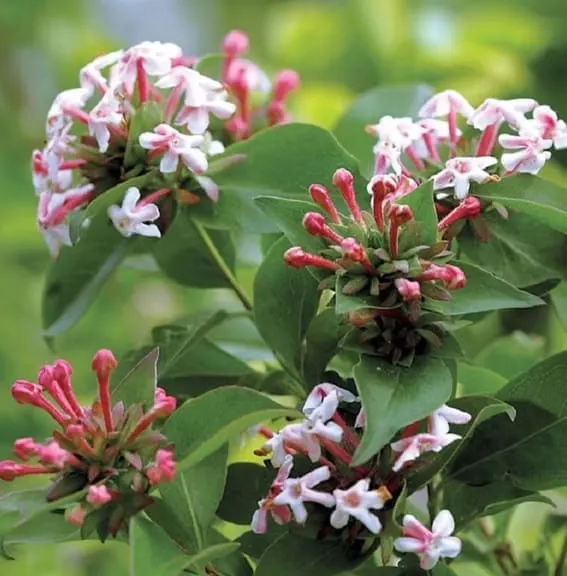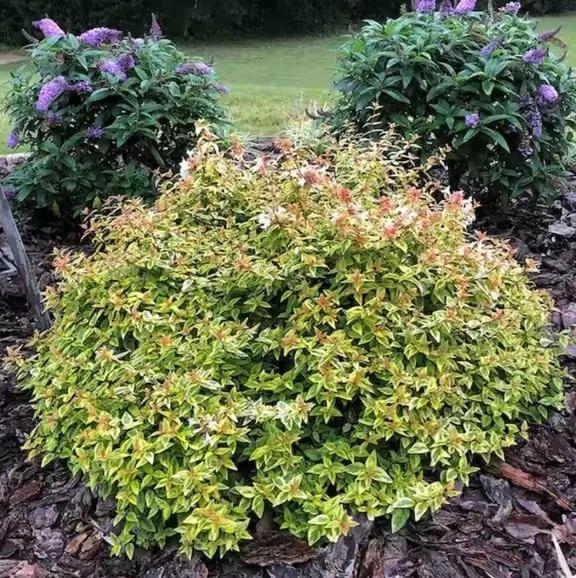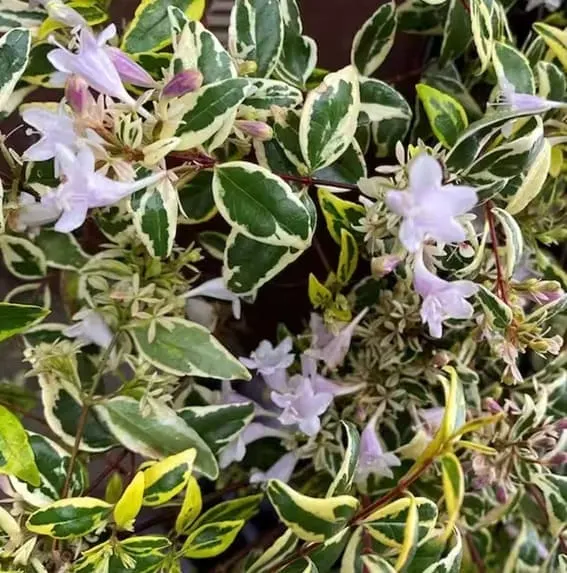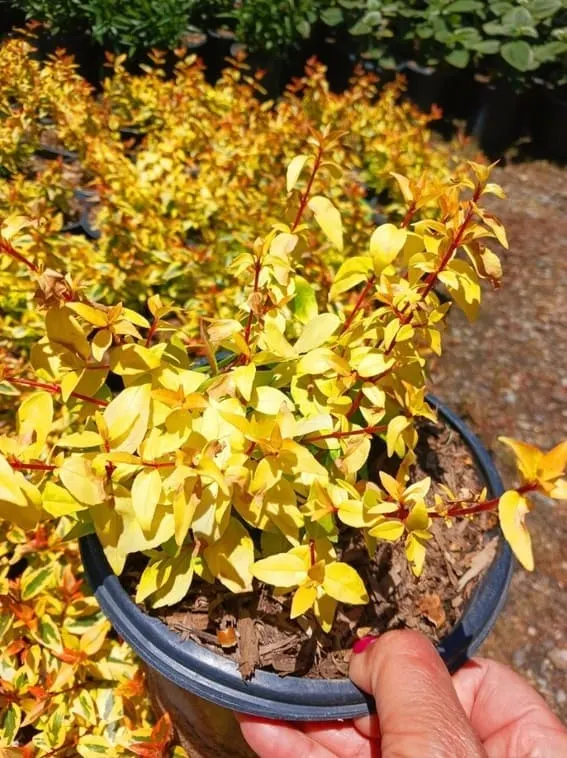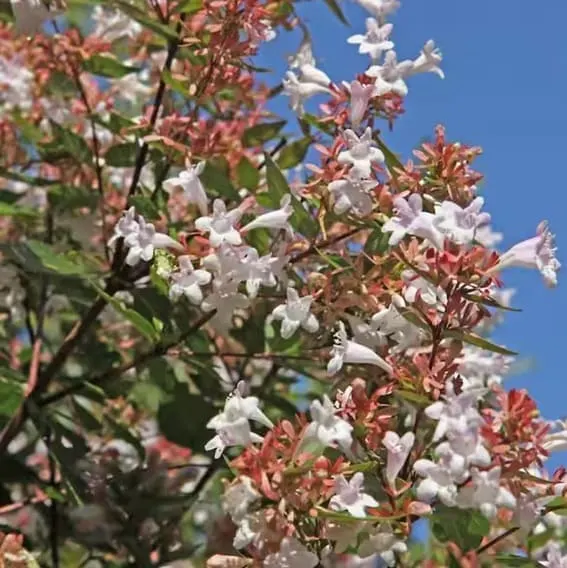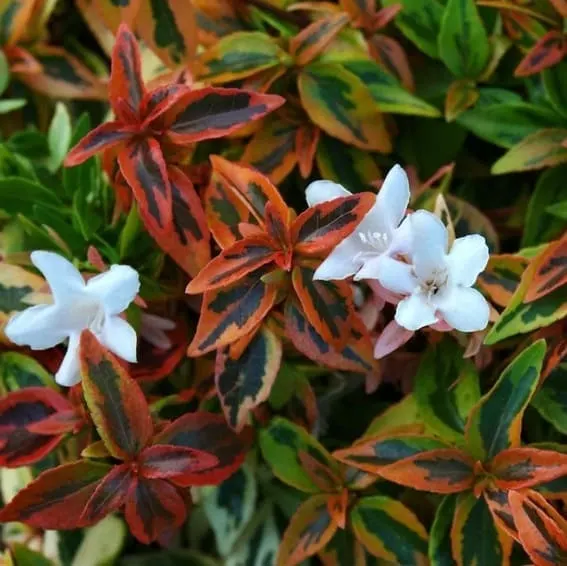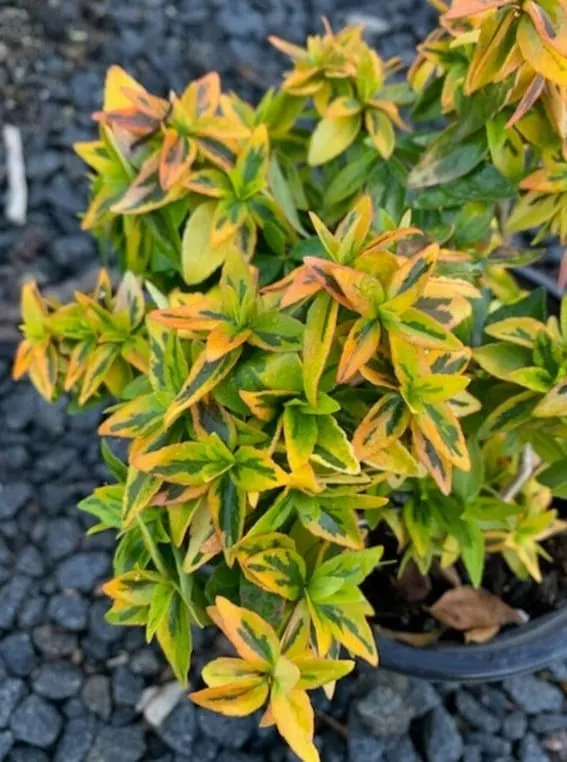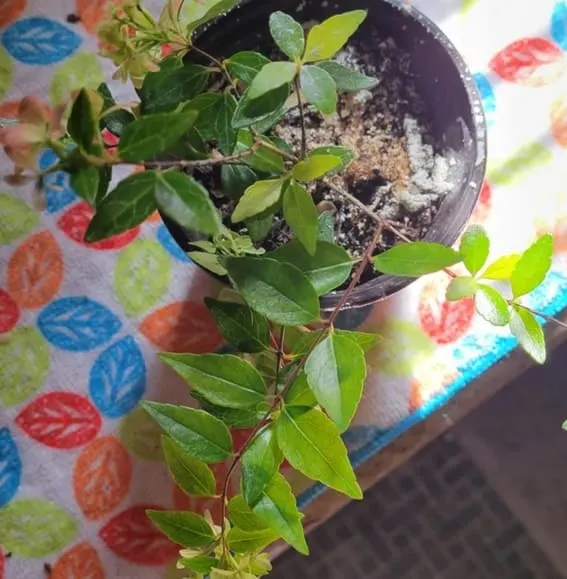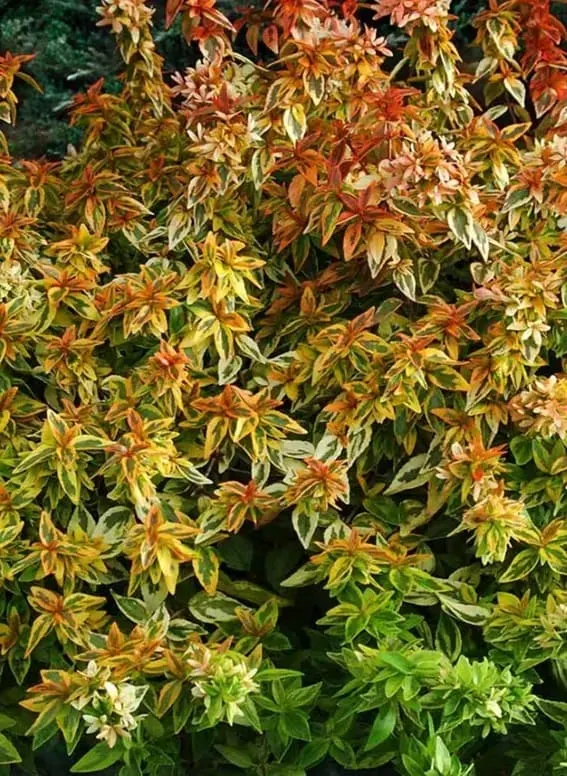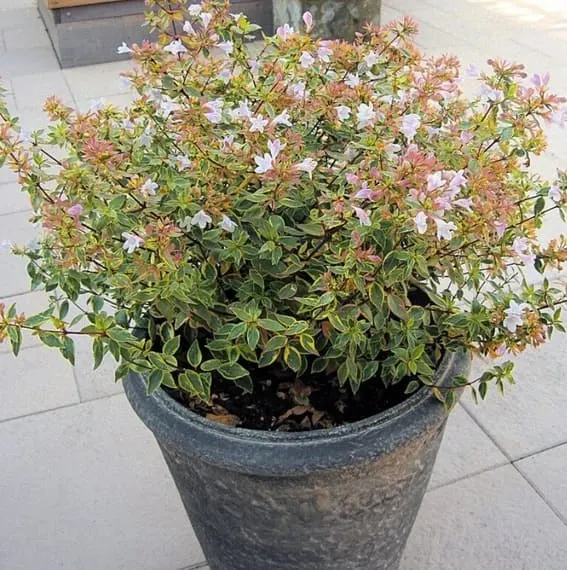Abelia perennial plant growing guide: How to Grow and Care for Abelia plant to make a colorful statement in your garden!
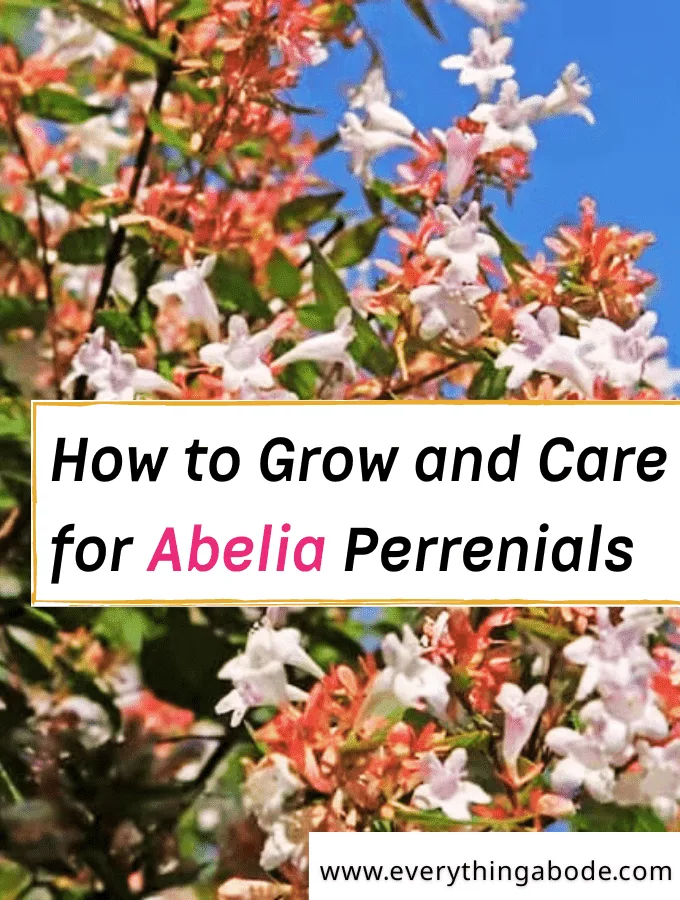
Abelia plants are popular for gardeners looking to add color and visual interest to their landscape.
With their colorful foliage and long blooming period, these low-maintenance shrubs are perfect perennials for various landscaping needs.
The masses of pretty pink and white flowers at the end of arching branches make for a dramatic effect in the garden.
Whether you’re planting them as a border, foundation, or hedge, abelias offer abundant beauty with minimal upkeep required.
Take a look at this guide on how to care for your abelia plant.
Related: Tall Garden Phlox: A Beautiful And Easy-To-Care-For Perennial Plant
Abelia Overview
Abelia plants are native to East Asia, which includes countries like China, Japan, and Korea.
Due to their adaptability, they’ve become popular ornamental plants in various regions worldwide.
With proper care and suitable growing conditions, your abelia plant will reward you with a stunning display of colorful foliage and beautiful blooms throughout the three seasons!
Not only that, but the Abelia plant is a versatile and attractive shrub that can add a touch of charm and sophistication to any garden.
Its popularity among gardeners is due to its colorful foliage and long blooming period. Unlike other shrubs, abelias are relatively low-maintenance plants and require little attention once established in the garden.
Abelias are part of the Abelia genus within the Caprifoliaceae family, which includes several species that vary in size, foliage, and flower color.
These shrubs are characterized by their arching branches and abundance of delicate, pink flowers during summer.
Abelias can be incorporated in many ways in the garden, such as borders, shrub plantings, foundation plantings, and hedges, if adequately maintained.
With various species, you can find the perfect abelia plant to suit your specific tastes and garden needs.
See Also: 12 Best Air Purifying Pet-Safe Houseplants You Could Own
Varieties of Abelia
When choosing the right Abelia for your garden, several varieties exist. This section will discuss Glossy Abelia, Compact Abelia, and Hybrid Abelia.
Glossy Abelia
Glossy Abelia (Abelia x grandiflora) is an evergreen or deciduous shrub depending on the warmth of the location where it’s grown.
The Miss Lemon Abelia variety, for example, features an arching form and is covered with an abundance of pink flowers every year in the summer. The glossy leaves contrast the flowers, creating a stunning visual impact in your garden.
This variety is perfect for those seeking a low-maintenance shrub that provides year-round visual interest.
Compact Abelia
Compact Abelia is a smaller version of the Glossy Abelia, making it an excellent choice for smaller gardens or foundation planting. The compact size allows it to fit into tight spaces and can be used for creating borders and hedges.
This variety retains most of the characteristics of the Glossy Abelia, including deciduous or evergreen leaves based on climate and pink flower clusters throughout the summer months.
Rose Creek Abelia
According to The Spruce, Rose Creek Abelia (Abelia x chinensis) is a variety of Abelia that features glossy green leaves which turn bronze in the fall. Its flowers change from pink to white, and it has deep red branches, giving it unique and interesting color combinations.
Hybrid Abelia
Hybrid Abelia (Abelia × grandiflora) is a cross between the Glossy Abelia and another species, resulting in various unique characteristics.
One well-known example is the Kaleidoscope Abelia, which offers variegated foliage in shades of green, yellow, white, and red – providing a striking look throughout the year.
Hybrid Abelia varieties can also have varying growth habits and flower colors, making them an ideal choice for those looking to add diversity and visual interest to their landscape.
When selecting an Abelia variety for your garden, consider size, growth habit, and foliage type.
Each of these three varieties offers distinct features that enhance your landscape while remaining low-maintenance and easy to care for.
Whether you choose a Glossy, Compact, or Hybrid Abelia, you will definitely enjoy its vibrant foliage, long bloom times, and overall charm for your garden.
See Also: 35 Small Indoor Houseplants That Can Fit Almost Anywhere
Abelia perennial plant growing guide
Abelia plants are versatile and can tolerate various conditions, making them an excellent choice for your garden. Here’s what they need to thrive in an outdoor garden:
Water.
While the Abelia is drought-tolerant once established, it is recommended to provide regular watering to keep the plant vibrant and healthy, particularly during the hotter summer months.
It is best to water the plant deeply and infrequently, once or twice a week, and allow the soil to begin drying before watering again. This is better for the plant than watering lightly and regularly.
Temperature
Regarding temperature, abelias are adaptable and can grow in various climates.
They are hardy plants that can withstand temperatures as low as 15°F (-9.4°C), making them suitable for hardiness zones 4 through 11.
To ensure the best growth, monitor the humidity levels around your plants, as they might need extra care if the air becomes too dry.
Sun
Regarding sun exposure, abelias flourish in both full sun and partial shade.
Ideally, they should receive at least six hours of direct sunlight each day, but if you have a partly shaded spot in your garden, don’t worry – they will still grow well.
It’s important to remember that too much shade may result in fewer flowers and reduced foliage color, so choose your planting location accordingly.
Soil Requirements
These plants prefer fertile, well-draining, and moist soil, so it’s a good idea to amend your soil with compost before planting. This will help ensure the ground is rich in organic matter, promoting healthy growth.
Abelia prefers well-draining soil to prevent root rot and other issues caused by excess moisture.
The ideal soil type for Abelia is a mixture of fertile soil with some sand, which promotes excellent drainage.
Abelia thrives best in slightly acidic soil with a pH range of 6.0 to 6.5.
To determine your soil’s pH level, use a soil test kit or bring a sample to your local garden center for testing.
If your soil is too alkaline, you can amend it with elemental sulfur or an acidifying fertilizer. Conversely, use lime to raise the pH level if your soil is too acidic.
Abelia perennial plant growing guide: Planting Your Abelia Plant
Planting Abelia is rather quite easy; here is how to plant and where:
- Choose a location allowing the plant to receive full sun and partial shade.
- Dig a hole twice as wide as the root structure, ensuring that the top of the root system is slightly above the ground. This will promote proper drainage and prevent root rot.
- Space your Abelia plants far apart to accommodate their mature size, as these shrubs can grow quite broad.
- Mix some organic matter, such as compost, with the surrounding soil to improve planting aeration and drainage.
- Water your newly planted Abelia thoroughly, then water it intensely regularly during the first growing season. This will help establish the root system and encourage healthy growth.
See Also: 15 Stunning Pink House Plants For The Home
Abelia perennial plant growing guide: Propagation Methods
There are two primary methods for propagating Abelia: seeds and cuttings.
Seeds
Although not the most common method, you can grow Abelia from seeds.
- Collect seeds from the mature shrub or store-bought, clean them, and plant them in containers filled with potting soil.
- Choose a sunny location with organically rich, moist, and well-draining soil, or fill a container with potting soil.
- Add seeds and press them into the soil so they are covered completely.
- Keep the soil moist and provide them in a warm, sunny location. Germination should occur within a few weeks.
Once the seedlings are large enough, transplant them into your garden or their permanent area.
Cuttings
The more popular method for propagating Abelia is stem cuttings. To do this, take softwood cuttings from healthy plants, preferably from the upper portion, during the late spring or early summer when the plant is actively growing.
Cuttings should be 4 to 5 inches long and at a 45-degree angle to promote rooting.
Before planting your cuttings:
- Dip the cut end into a rooting hormone to encourage root growth.
- Place the cuttings into containers filled with well-draining potting soil, and keep the soil consistently moist. You can also cover the containers with plastic bags to maintain humidity levels.
- Once the cuttings develop a robust root system, transplant them into your garden or their final location.
See Also: 27 Beautiful Indoor Houseplants You Have To See
Appearance and Maintenance
Leaves and Foliage
Abelia shrubs feature pointed, oval-shaped leaves that are often yellow or green with pink, orange, bronze, or burgundy details.
Some leaves on these plants are multi-colored or variegated, adding visual interest as they change color with the seasons.
Flowers and Bloom Time
The abelia shrubs’ flowers are tubular, typically seen in white, pink, or yellow shades.
These vibrant blooms add a splash of color to your garden, with some varieties featuring colorful sepals that persist even after the petals fall.
The Abelia’s bloom usually extends from late spring to fall, providing months of beautiful blossoms.
To help your Abelia produce the maximum number of flowers, plant your shrub in an area with full sun or partial shade.
Abelia perennial plant growing guide: Abelia Care
Taking care of Abelia plants is quite simple once they are established.
This section will cover essential aspects of Abelia’s care, including fertilizer requirements, pruning, and deadheading.
Fertilizer Requirements
Fertilizing your Abelia is essential for promoting its overall health and ensuring an abundance of blooms.
Use a slow-release fertilizer with a balanced N-P-K ratio (nitrogen, phosphorus, and potassium) to give your plant essential nutrients.
Apply the fertilizer in early spring and then again in mid-summer.
Consider adding a layer of organic mulch around the base of your plant to provide additional nutrients while also helping retain moisture in the soil.
Pruning
Pruning your Abelia plant is vital for maintaining its shape and encouraging new growth.
Prune in late winter or early spring while the plant is dormant to ensure proper growth.
Remove dead, damaged, or overcrowded branches, cutting back to a healthy lateral branch or bud.
You can also shape the plant by pruning back long, leggy stems, but avoid cutting back more than one-third of the total height of the plant to prevent stress.
Deadheading
Deadheading refers to the process of removing spent flowers from your Abelia plant.
Although not required, deadheading can help promote continuous blooming and keep the plant looking tidy.
Regularly pinch or trim off spent blooms throughout the flowering season to encourage new buds.
Be sure to maintain a neutral and consistent level of care during this process to keep your plant healthy.
See Also: 6 Best Bedroom Plants That’ll Improve Your Health And Wellness
Container Planting Abelia Plants
Abelia shrubs are great for container gardening due to their compact growth habit and honeysuckle-like blooms.
Choose a pot with adequate drainage holes and a well-draining potting mix.
Abelia can adapt to various light conditions, but at least 6 hours of sunlight daily is ideal. Water regularly, ensuring excess water can drain away freely.
With proper care, Abelia can thrive in your container garden all season.
Landscaping Uses with Abelia Shrubs
Abelia shrubs provide a long blooming period with colorful foliage and attractive flowers. Their arching branches and rounded shape can serve multiple purposes in your landscape design.
Creating a Hedge: Abelia’s dense growth habit makes it an excellent choice for a hedge. Plant the shrubs close together, and they will form a thick and appealing privacy screen.
Border Plantings: Add visual interest along pathways, fences, or driveways by using Abelia as border plantings. Their blooming activity from summer to fall will give a splash of color to the border areas.
Foundation Plantings: Abelia shrubs work well as foundation plantings around your home. They help to soften the appearance of bare walls and can even be used to conceal utility fixtures. Remember to provide enough space for your Abelia to grow, as they can reach 3-6 feet in height and width.
Pest and Disease Control
According to Southern Living, Abelia might encounter powdery mildew, anthracnose, and other fungal diseases if the shrubs do not receive proper care.
Anthracnose usually occurs when shrubs are overwatered and powdery mildew is present in plants that do not receive enough air circulation or sun exposure.
Although Abelia plants are hardy, they can be vulnerable to certain pests and diseases.
Aphids can damage the plant by sucking sap from the leaves and stems, and anthracnose can cause dark spots on the leaves.
Root rot can also occur in poorly-draining soil conditions. To prevent these issues, maintain good care by providing adequate sunlight, water, and nutrients.
Use natural or chemical pesticides to eliminate pests, remove infected leaves and apply fungicides for diseases.
Proper pruning and spacing, avoiding overhead watering, and spreading mulch can also help maintain good air circulation and soil moisture.
Overwintering and Climate Considerations
There are a few factors to consider when it comes to overwintering abelia plants.
Abelias are low-maintenance and possess evergreen foliage, making them an attractive option for city and suburban gardens.
Knowing your USDA hardiness zone is essential to ensure the health and vigor of your abelia plant during winter.
Most abelia varieties can withstand temperatures in USDA zones 4 to 11, while others can be more cold-sensitive.
If you live in an area with harsh winters, consider planting your Abelia in a protected location, such as near a south-facing wall or in a sheltered place to reduce the impact of wind.
Additionally, you can apply a layer of organic mulch around the base of the plant, which will help maintain soil moisture and insulate the roots from temperature fluctuations during the winter months.
If grown in a container in a colder region, protect the plant by moving it indoors before the first frost.
Frequently Asked Questions
What are the ideal growing conditions for Abelia?
Abelias thrive in full sun or partial shade and require well-draining soil. They prefer moderate moisture levels, with approximately 1 inch of water per week during the growing season. Soil should be slightly acidic or alkaline.
How fast does Abelia grow?
Abelias are considered moderate growers, reaching their mature size of 3-6 feet in height and width within a few years. Growth rates may vary depending on the specific species and growing conditions.
When and how should I prune an abelia plant?
Pruning is best done in early spring before the growing season begins. However, light pruning can be done throughout the season to maintain the desired shape and size. Always use clean, sharp pruning shears and remove damaged, crossing, or poorly placed branches.
Do abelias attract pollinators?
Yes, abelias are attractive to pollinators such as bees, butterflies, and hummingbirds, thanks to their tubular flowers and long blooming season. Planting abelias in your garden is a great way to support your local pollinator population.
What are common issues or pests affecting abelias?
Abelias can be affected by common pests such as aphids, spider mites, and scale insects. Look for signs of infestation, and treat as needed with insecticidal soap, neem oil, or other appropriate pest control measures. Additionally, maintain proper watering, feeding, and pruning practices to keep your Abelia healthy and less susceptible to disease or pest problems.
There you have it. Understanding the specific characteristics of your abelia plant and taking note of climate considerations will enhance its overwintering success.
Moreover, if you provide proper protection and consider your plant’s hardiness zone, your Abelia plant will continue to be an attractive and low-maintenance addition to your city or suburban garden.
Up Next: Tall Garden Phlox: A Beautiful And Easy-To-Care-For Perennial Plant
Author: Everything Abode
Welcome to Everything Abode, your daily inspiration for every activity at home!
Our goal is to inspire you to live an elegant and chic lifestyle from the comfort of your home.
We’ll help you express yourself through authentic style, aesthetic beauty, and stylish home decor.
27 Beautiful Indoor Houseplants You Have to See
6 Best Bedroom Plants That'll Improve Your Health and Wellness
26 Amazing Gifts for Plant Lovers That'll Be A Big Hit
10 Best Indoor Plants That'll Help Purify The Air In Your Home
Tall Garden Phlox: A Beautiful and Easy-to-Care-For Perennial Plant
Houseplants for the Bathroom: 14 Varieties That'll Love the Humidity
Subscribe to Get the Tools That Make My Blog Successful!

When you join my newsletter, I'm going to send you insider advice and tools that I use to grow my blog! I only save the BEST for my email list so don't wait!

